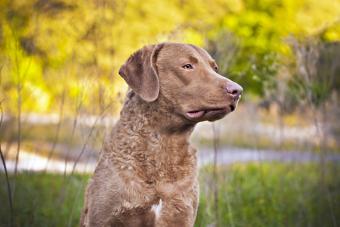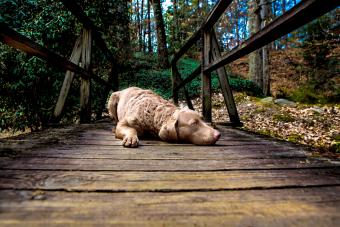
The clear golden amber eyes of Chesapeake Bay Retrievers will capture your attention. Their endearing personality will hold onto your heart. Their loyalty comes unmatched and they will quickly become a critical, loving part of your family.
Origins and History
One of the few breeds that can claim to be born in the United States is the Chesapeake Bay Retriever. The breed was originated in 1807, when two Newfoundland dogs named Sailor and Canton were traveling aboard a ship destined for England. The crew and two dogs, Sailor, a red male, and Canton, a black female, were saved after the ship ran aground. Canton was placed with Dr. James Stewart of Sparrow's Point, while Sailor was placed with John Mercer of West River.

Both dogs developed a reputation as outstanding water dogs, particularly when it came to duck hunting, and their puppies acquired their ability - as well as their unique yellowish or amber-colored eyes. There was no record of the two dogs mating, but when strains from the eastern and western sides of Maryland met in Baltimore in 1877 for the Poultry & Fanciers Association show, their similarities were enough for them to be recognized as one breed, "The Chesapeake Bay Ducking Dog," which is now known as the Chesapeake Bay Retriever.
A distinct Chesapeake variation had been developed by the time the American Kennel Club was founded in 1884, and it was widely recognized for its ability in the chilly waters of the Chesapeake Bay. In 1918, the American Chesapeake Club was founded.
Characteristics of the Breed
Chesapeake Bay Retrievers are recognized for their thick, water-shedding fur, love for swimming, bright and cheerful demeanor, intelligence, and courage. Continue reading to learn more.

Appearance
As a water dog, the Chessie has developed a cat that resists water similar to the way duck feathers do. Their top coat is short, thick, and oily. Their undercoat is fine, dense, and soft. Combined, they provide protection against the elements whether it's ice, snow, or cold water. This doesn't necessarily mean these dogs should be subjected to this weather. You should still follow the guidelines as you would for other dogs. Don't keep a Chessie trapped in the dog house outside. Ensure you have the time and attention to dedicate to this breed.
The American Chesapeake Club illustrates the following acceptable coat colors:
- Light Deadgrass
- Deadgrass
- Tan
- Sedge
- Light Brown
- Brown
- Dark Brown
- Ash
The head of both sexes should be broad, with a somewhat domed top skull, short ears, and trademark clear yellow/amber eyes. Chesapeake Bay Retrievers are solid, sturdy dogs, slightly longer in body than they are tall. The depth of the chest should extend to the elbow, or slightly below. The average size of males and females are:
Males
- Height: 23 to 26 inches
- Weight: 65 to 85 pounds
Females
- Height: 21 to 24 inches
- Weight: 55 to 70 pounds
Temperament
Chessies are known for their bright, happy demeanor combined with a strong work ethic, high level of intelligence, courage, and loyalty. Along with their intelligence comes a streak of stubborn behavior, which means you will need to be firm and consistent in your commands and desires.
They are well-known for their 'I'm going to do this' attitude. Once they have a goal, they are determined to reach it. This could range from a heavy desire to go find the duck if you're hunting or wanting that juicy pork chop on the counter. With proper training and exercise though, this breed is quite obedient and will obey the rules of the house.
This breed is normally fond of children, but will not accept excessive harassing and will flee if they are not properly cared for. They are generally recommended in families without small children since they can become food or toy possessive. They are known to defend children once they have formed a bond with them, which has its own set of benefits and drawbacks. They will defend your family, but they may misinterpret playtime with friends or strangers. In a home with a Chessie, children should be at least 8 years old.
When it comes to other dogs, Chessies can be aggressive and possessive if they are not familiar with them. However, they frequently get along with the dogs and cats with whom they were raised.
Socialization is important in ensuring that your Chessie puppy develops into a well-rounded dog. Enrolling him in puppy kindergarten is a terrific place to start. Regularly inviting visitors over and taking them to crowded parks, dog-friendly stores, and leisurely strolls down the street or around the block can all help them improve their social skills.
Exercise Requirements
The Chesapeake Bay Retriever requires a significant amount of exercise to remain happy, healthy, and free of destructive behaviors. If they receive their daily exercise, they're more than willing to sit down on the couch with you and watch a movie or cuddle up to a TV show.
A minimum of 30 minutes to one hour of vigorous exercise is recommended each day. This could involve intensive work like hunting or water retrieves, obedience training, or intense play. They also enjoy relaxing walks and this could provide some extra physical and mental stimulation.
Chessies also obviously love to swim and will do best if swimming can be included at least several days per week. They often don't do extremely well in the city and are well-known as a country dog. If you live in the city, ensure you have somewhere with plenty of space for fun and exercise.

It's also important to keep in mind that puppies have different exercise needs than adult dogs. Their exercise routine is often broken up into stages:
- 9 weeks to 4 months old: Puppy kindergarten or some type of obedience training and 20 minutes or so of soft play in the yard is all that's recommended. You can also grab a kiddie pool for them to play in.
- 4-6 months: Weekly obedience classes and a walk of about half of a mile as well as playtime in the yard is recommended. They can also begin swimming in the local lake or pond if there's one nearby.
- 6 months-1 year: About 40 minutes of playtime and continued training in short spurts is recommended, but only in cool temperatures. They can become quickly overheated in relatively hot temperatures. Walks should continue to be limited for no longer than half of a mile.
Once your Chessie turns one year old, they can now begin to jog with you, but never more than one mile and while ensuring frequent breaks. As your Chessie gets older, you can increase the distance or amount of exercise. The purpose of the segmented exercise routine is to protect your Chessie's developing bones and joints to prevent problems in the future.
Training
Chessies adore their owners, but they can also be stubborn and have their own thoughts. Positive reinforcement is important with every dog, but it's particularly important to mention here. Positive reinforcement involves correlating training with a positive item or action like food rewards and praise.
If punished or scolded, the Chessie will quickly become more stubborn and defiant. Continue training, remain patient, and utilize positive reinforcement and your Chessie will become a well-rounded, well-trained dog.
Health Concerns
Like so many other purebred dogs, Chessies face their share of health issues. In an effort to identify and work toward irradicating genetic problems in the breed, the American Chesapeake Club has taken a health survey amongst registered breeders.

The most common health problems encountered with this breed turned out to be:
- Canine Hip Dysplasia: A genetic condition in which the bone of the 'thigh' does not fit snugly into the joint of the hip. Some dogs indicate pain and lameness in one or both rear legs, but a dog with hip dysplasia may not show any signs of discomfort until arthritis progresses.
- Progressive Retinal Atrophy: A degenerative eye disease that results in the loss of photoreceptors at the back of the eye, eventually leading to blindness. This can often be detected early, before the dog shows any signs of blindness, which helps you prepare and gives time to learn about the condition.
- Canine Epilepsy: A condition that causes mild to severe seizures. Medication can help manage epilepsy, but it cannot cure it. With correct management of this condition, a dog can live a long and healthy life.
- Cancer: Chessies are more prone to developing lymphoma than other breeds. Cancer may be treated with chemotherapy, radiation, surgery, and/or holistic procedures.
Lifespan
The Chessie has an average life expectancy of 10 to 13 years.
Fun Facts About the Chessie
As with many other breeds, the Chesapeake Bay Retriever has its own set of unique facts including:
- Paul Walker, the famous action in the Fast and Furious franchise, owned a Chesapeake Bay Retriever named Boone
- President Theodore Roosevelt owned a Chesapeake Bay retriever named Sailor Boy
- A Chessie is born to spend time in the water and have webbed feet to aid in swimming
- Chessies were declared the state dog of Maryland in 1964
- The Chessie is the mascot of Maryland University
Buying or Adopting a Chesapeake Bay Retriever
If you want to bring a Chesapeake Bay Retriever home, the price can vary significantly depending on whether you adopt one from a rescue organization or buy one from a breeder. Adopting a dog would likely cost around $300, but purchasing a dog from a breeder will cost at least $900 and could cost up to $5,000.
Breeders
The Chesapeake Bay Retriever Club advises new puppy buyers to make sure they are buying a puppy from a reputable breeder by verifying that both parents of any litter they are considering have undergone the necessary testing including:
- The PRA status of both parents of any litter they are planning (clean, carrier, or afflicted). Dogs with the carrier gene can still be bred, but only to 'clear' dogs in order to avoid generating affected pups. When both parents are clear, the offspring will be clear as well.
- BVA/KC Eye Testing to check for genetic cataracts.
- Degenerative Myelopathy testing results.
- The BVA/KC Hip Scoring Scheme keeps track of all dogs that have been hip scored by the Chesapeake Bay Retriever Club. Most breeders try to breed dogs with a hip score of average or lower. At this time, a Chesapeake has an average total score of 10.
The Chesapeake Bay Retriever Club offers a directory to find reputable breeders. Purebred Chessies can also be found using the AKC directory.
Rescues
The Chesapeake Bay Retriever Relief & Rescue group offers a nationwide database of Chessies to choose from. You can also search the listings on Petfinder and Save-a-Rescue to find Chessies and Chessie mixes in all-breed rescues and shelters.
Is a Chessie Right for You?
These wonderful dogs are true-blue companions, however, their size and athletic nature requires an outlet. Caring for a Chesapeake Bay Retriever includes giving them plenty of physical exercise and mental stimulation as well. Without it, these otherwise intelligent, even-tempered dogs will suffer from boredom and may become destructive in an effort to keep busy.
Apartment living is also not the ideal situation for a Chesapeake Bay Retriever, whose greatest love is to be in the field or the water. If you can't provide your pet with plenty of blue skies and fresh air, it would be better not to own a Chessie.
If you're ready for the commitment of a high-energy dog, and you have the time and space, this could be the breed for you.







